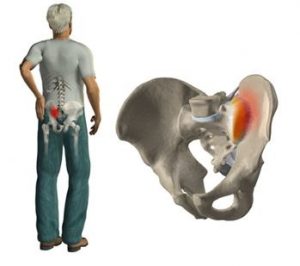Pain Management
Sacroiliac (SI) Joint Pain
By A.S. (staff writer) , published on November 09, 2021

Medicine Telehealth Health Sacroiliac Joint Pain SI Managemenet
The Sacroiliac joints link the spine to the hips. Basically, they are positioned between the iliac bones and the sacrum. Both joints offer support and stability and a significant amount of shock absorption during walking and lifting. The sacroiliac joints are positioned below the waist, from where two dimples are visible from the back.
Strong ligaments and muscles support the sacroiliac joints. For typical bodily flexibility, the joint has a very modest range of motion. Our bones get rheumatic, and our ligaments tighten as we age. When the cartilage deteriorates, the bones may rub against one another, resulting in discomfort.
The Sacroiliac joint is a fluid-filled synovial joint. This joint contains exposed nerve endings, resulting in persistent discomfort if the joint degenerates or does not function correctly.
Symptoms of Sacroiliac Joint Pain
Each individual has a unique experience with the symptoms of SI joint problems. Typical symptoms include the following:
• Lower back discomfort
• Buttocks, hips, and pelvic pain
• Hip discomfort restricted to a single SI joint
• Pain while rising from a seated posture
• Stiffness or a burning feeling in the pelvic
• Numbness
• Weakness
• Radiating agony down the thighs and upper legs
• A sensation that your legs may buckle and fail to support your body
Some Common Causes of Sacroiliac Joint Pain
Sacroiliac joint pain can occur due to a variety of factors, including the following:
• Injuries caused by trauma
An abrupt impact, such as a car accident or a tumble, might result in a sacroiliac joint injury.
• Arthritis
Sacroiliac joints can develop wear-and-tear arthritis (osteoarthritis), as well as ankylosing spondylitis — a kind of inflammatory arthritis that affects the spine.
• Pregnancy
For less complex delivery cases, the sacroiliac joints must relax and stretch. Pregnancy's increased weight and changed stride might place additional strain on these joints, resulting in abnormal wear.
• Infection
The sacroiliac joint can get infected in rare instances.
Rehabilitation and Prevention for Sacroiliac Joint Pain
A good attitude, consistent activity, and an expedited return to work are critical components of rehabilitation. If routine work responsibilities are initially impossible to execute, a modified (light or restricted) duty may be prescribed for a limited period.
Preventing recurrences is critical:
• Techniques for lifting correctly
• Proper posture is necessary for sitting, standing, moving, and sleeping.
• Exercise regularly that include stretching/strengthening
• An ergonomic work environment
• Appropriate diet, a healthy body weight, and a lean body mass
• Techniques for stress management and relaxation
• Smoking is prohibited
Treatment of Sacroiliac Joint Pain
The treatment for sacroiliac joint pain is determined by your indications and symptoms, as well as the etiology.
Medications
Your doctor may prescribe the following treatments, depending on the source of your pain:
• Anti-inflammatories
If over-the-counter pain relievers are ineffective, your doctor may prescribe stronger versions of these medications.
• Muscle Relaxants
Cyclobenzaprine and Tizanidine may help alleviate the muscular spasms that are frequently associated with sacroiliitis.
• Anti-TNF Agents
TNF inhibitors — such as etanercept (Enbrel), adalimumab (Humira), and infliximab (Remicade) — frequently alleviate sacroiliitis associated with ankylosing spondylitis.
Physical Therapy for Sacroiliac Joint pain
Your physician or physical therapist can teach you range-of-motion and stretching exercises that will help you maintain joint flexibility and strengthening exercises that will help your muscles become more stable.
Operations Surgical and Non-Surgical
If none of the previous techniques works, your doctor may recommend the following:
• Injections of joints Corticosteroids
Injections can be used to decrease inflammation and discomfort in the joint. It would help if you only had a few joint injections each year because the steroids can weaken the bones and tendons in your joint.
• Denervation by Radio Frequency.
Radiofrequency radiation can cause significant damage or destruction to the nerve tissue that is causing your pain.
• Stimulation by Electricity
Sacroiliitis discomfort may be alleviated by implanting an electrical stimulator into the sacrum.
• Fused joints
Although surgery is seldom used to treat sacroiliitis, joining the two bones with metal hardware can occasionally alleviate discomfort associated with sacroiliitis.
References
-
Sacroiliac joint pain. Mayfield. httos://mayfieldclinic.cornipe-snointoain.htma,text=Sacroiliac joint pain determine.
-
Mayoclinic staff. Sacroiliitis. Mayoclinic. httos://www.mayo clinic.
-
Spine-health. Jul 2018. https://www.spine-health.comkonditions/sacroiliac-ioint-dysfunction/sacroiliac-joint-pain
Find articles related to: Medicine Telehealth Health Sacroiliac Joint Pain SI Managemenet
More articles about Pain Management
Back to the Health Tips Index




